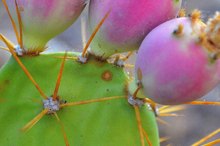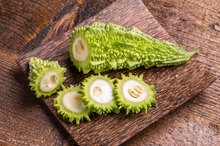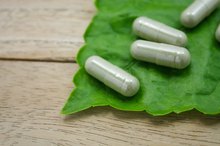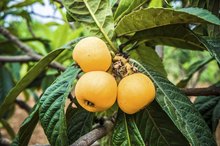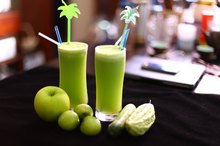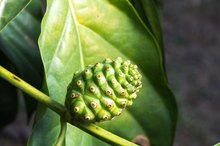What does fact checked mean?
At Healthfully, we strive to deliver objective content that is accurate and up-to-date. Our team periodically reviews articles in order to ensure content quality. The sources cited below consist of evidence from peer-reviewed journals, prominent medical organizations, academic associations, and government data.
- Plant Foods for Human Nutrition: Determination of Antioxidant Constituents in Cactus Pear Fruits
- Plant Foods for Human Nutrition: Determination of Antioxidant Constituents in Cactus Pear Fruits
- Harvard School of Public Health: Antioxidants -- Beyond the Hype
- Weiner Klinische Wochenschrift: Effect of Prickly Pear (Opuntia Robusta) on Glucose- and Lipid-Metabolism in Non-Diabetics With Hyperlipidemia
- Weiner Klinische Wochenschrift: Effect of Prickly Pear (Opuntia Robusta) on Glucose- and Lipid-Metabolism in Non-Diabetics With Hyperlipidemia
- Phytotherapy Research: Diuretic and Antioxidant Effects of Cacti-Nea, a Dehydrated Water Extract From Prickly Pear Fruit, in Rats
- Phytotherapy Research: Diuretic and Antioxidant Effects of Cacti-Nea, a Dehydrated Water Extract From Prickly Pear Fruit, in Rats
- Nutrition Journal: Cactus Pear -- A Natural Product In Cancer Chemoprevention
- Nutrition Journal: Cactus Pear -- A Natural Product In Cancer Chemoprevention
- Nutrition and Cancer: Cactus Pear Extracts Induce Reactive Oxygen Species Production and Apoptosis in Ovarian Cancer Cells
- Nutrition and Cancer: Cactus Pear Extracts Induce Reactive Oxygen Species Production and Apoptosis in Ovarian Cancer Cells
The information contained on this site is for informational purposes only, and should not be used as a substitute for the advice of a professional health care provider. Please check with the appropriate physician regarding health questions and concerns. Although we strive to deliver accurate and up-to-date information, no guarantee to that effect is made.
Health Benefits of Cactus Tea
Cactus tea, also sometimes called nopal tea or prickly pear tea, is made from dehydrated prickly pear 1. Prickly pear is common to Latin American diets, where the fruits are eaten whole 1. They are also frequently made into juices or teas, which also yield health benefits. Cactus tea is rich in antioxidants, aiding with cholesterol and lipid levels, and is also a natural diuretic.
Rich in Antioxidants
While varieties of cactus fruit have differing amounts of antioxidants, they are all naturally rich in a number of flavonoids, carotenoids, phenolics and vitamin C, also known as ascorbic acid. Antioxidants protect your body’s cells from potential damage, and they can also slow down damage that can come from exposure to free radicals and toxins such as environmental pollutants. Antioxidants can potentially protect your body from heart disease and cancer, although research on their efficacy is still ongoing.
Improved Blood Glucose and Cholesterol Levels
Nutrition Facts of Nopal Cactus
Learn More
A study published in 2002 in “Weiner Klinische Wochenschrift,” a German medical journal, found that taking prickly pear steadied blood sugar levels and lowered cholesterol levels in nondiabetic patients 1. The human study was conducted over an eight-week period and found that low density lipoprotein levels were reduced by 15 percent and total cholesterol levels by 11 percent. While scientists could attribute the improved insulin sensitivity to prickly pear’s antioxidant content, they felt further research was needed regarding the cholesterol effect, which might be attributed to the dietary fiber content of the fruit 1.
A Natural Diuretic
An animal study published in a 2010 issue of “Phytotherapy Research” found that prickly pear was a natural diuretic 15. Because of its diuretic effects, the prickly pear supplement the rats took -- 240 milligrams per kilogram of body weight per day -- also caused them to lose significant weight by the end of the study period 1. Scientists concluded that prickly pear extracts could potentially be useful as a treatment for water retention, but further research is still needed 1.
Potential Anti-Cancer Benefits
What Are the Health Benefits of Gohyah Tea?
Learn More
A study in a 2005 issue of “Nutrition Journal” found that the antioxidant compounds in prickly pear, in a water solution, restricted the growth and development of several cancer cells in a lab setting 16. The prickly pear water extract also suppressed tumor development in mice 1. The studies showed such promise that the scientists pursued further research, publishing their findings in a 2010 issue of “Nutiriton and Cancer.” Their later study found that a water extract of prickly pear led to strong growth reduction in ovarian cancer cells 1. The reduction was so great that there were significant instances of apoptosis, or cell death, in cancer cells, which suggests that the powerful antioxidant effects of prickly pear extract could potentially stop cancer development 1. However, further long-term and human study is still required.
Brewing Cactus Tea
To make cactus tea, use 1 1/2-teaspoons of tea leaves per 8 ounces of boiling water. Because it is considered an herbal tea, cactus tea can tolerate hotter water temperatures. Heat your water to 208 degrees Fahrenheit, and then allow the tea to steep for five to six minutes. If you are making iced cactus tea, double the amount of tea used and roughly double the steeping time: 3 teaspoons in 8 ounces of hot water for eight to 15 minutes. Once the tea is steeped, pour it over a glass filled with ice cubes. If you are using a tea bag, use one tea bag per 8 ounces of hot water, doubling the amount for iced tea.
- To make cactus tea, use 1 1/2-teaspoons of tea leaves per 8 ounces of boiling water.
- If you are using a tea bag, use one tea bag per 8 ounces of hot water, doubling the amount for iced tea.
Related Articles
References
- Drugs.com: Prickly Pear
- Plant Foods for Human Nutrition: Determination of Antioxidant Constituents in Cactus Pear Fruits
- Harvard School of Public Health: Antioxidants -- Beyond the Hype
- Weiner Klinische Wochenschrift: Effect of Prickly Pear (Opuntia Robusta) on Glucose- and Lipid-Metabolism in Non-Diabetics With Hyperlipidemia
- Phytotherapy Research: Diuretic and Antioxidant Effects of Cacti-Nea, a Dehydrated Water Extract From Prickly Pear Fruit, in Rats
- Nutrition Journal: Cactus Pear -- A Natural Product In Cancer Chemoprevention
- Nutrition and Cancer: Cactus Pear Extracts Induce Reactive Oxygen Species Production and Apoptosis in Ovarian Cancer Cells
- Alam, F., Saqib, Q. (2017). Evaluation of Zanthoxylum armatum Roxb for in vitro biological activities. Journal of Traditional and Complimentary Medicine.
- Alina Health staff. Northern Prickly Ash. Alinahealth.org.
- Bafiyeboa, N. (2005). Antifungal constituents of Northern prickly ash, Zanthoxylum americanum mil. Phytomedicine. 12 (5): 370–377.
- Passero, L., Lago, J. (2013). Zanthoxylum. In Vivo Antileishmanial Activity of Plant-Based Secondary Metabolites. ScienceDirect.com.
- Tillotson, A. PRICKLY ASH BARK (Zanthoxylum species). ChrysalisNaturalMedicineClinic.com.
- USDA/NRCS. Plant Guide. Common Pricklyash, Zanthoxylum americanum P.Mil. USDA.Plants.gov.
- Whealan, R., Certified Medicinal Herbalists. Herbs from A to Z: Prickly Ash. RJWhelan.co.nz.
- Yong, J., Still, C., Sacalis, JN., Jiangang, L., Chi-Tang, H. (2001). "Cytotoxic coumarins and lignans from extracts of the northern prickly ash (Zanthoxylum americanum)". Phytotherapy Research. John Wiley & Sons. 15 (5): 441–443.
Writer Bio
Lana Billings-Smith has been writing professionally since 1997. She has been published in the "Montreal Gazette" and the "National Post." She also teaches and lectures at McGill University. A certified personal trainer, she holds a Bachelor of Arts with a specialization in leisure sciences and a minor in therapeutic recreation.
